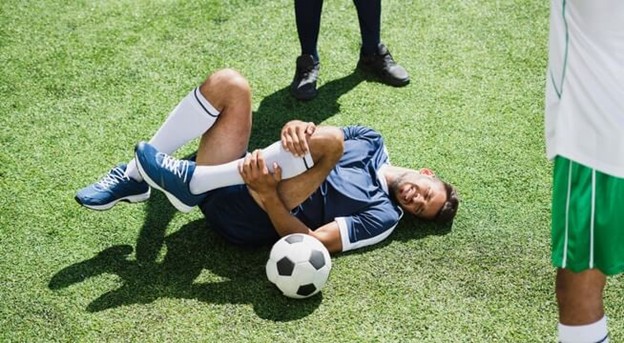Soccer is a continuous blend of sprints, sharp cuts, sudden stops, tackles, jumps, and landings. Those same actions can irritate tendons, strain muscles, and overload joints when workload, technique, and recovery fall out of balance. The scenarios below mirror what clinicians see every week. Each pair a familiar problem with a practical, evidence-based plan so players can recognise trouble early, act confidently, and return safely.

The Pivoting Knee
A quick change of direction or awkward landing can strain the medial collateral ligament or, in severe cases, the anterior cruciate ligament. Signs include a pop, rapid swelling, and a feeling that the knee gives way. Stop play, protect the joint, and arrange prompt assessment. Early care uses relative rest and swelling control, followed by physiotherapy for hip and quadriceps strength, balance, and controlled deceleration. Prevention focuses on landing mechanics, single-leg strength, and planned turn drills that keep the knee tracking over the toes.
The Touchline Ankle Roll
Lateral ankle sprains are common when a foot lands on an uneven surface or another player’s boot. Expect outer ankle pain, swelling, and difficulty weight bearing. Immediate steps are protection, compression, elevation, and brief icing for comfort. Begin a gentle range of motion as pain allows, then progress to balance work, single-leg calf raises, and hopping. A lace-up brace or supportive taping can help during the early return. Good boot fit, firm heel counters, and awareness in crowded areas reduce the chance of a repeat sprain.
The Sprinting Hamstring
Top speed chases place heavy demand on the hamstrings. A sharp grab high in the back of the thigh is typical. Early management is relative rest and protected walking, not total inactivity. Rehabilitation starts with pain-free range, bridges, and hip hinge drills, then progresses to eccentric strengthening such as Nordic curls and graded sprint mechanics. Return when you can run at near top speed, change pace, and decelerate without pain or apprehension. Ongoing posterior chain strength is the best protection.
The Groin From Cutting and Kicking
Repeated side steps and powerful crosses stress the adductors and hip flexors. Pain sits deep in the inner groin or the front of the hip and worsens with long passes, rapid cuts, or sudden stops. Useful first steps are load modification and isometric adductor work for pain relief. Progress with Copenhagen adductor exercises, trunk control, and hip mobility. Manage kick counts during the build back and avoid large jumps in training volume. Persistent catching or clicking deserves assessment for labral involvement.
The Keeper’s Shoulder and Fingers
Diving, overhead throws, and hard catches can irritate the rotator cuff or sprain finger joints. A simple plan helps most cases. Restore shoulder blade control, external rotation strength, and thoracic mobility, then rebuild overhead work gradually. Finger injuries need prompt assessment, short protection, and buddy taping as motion returns. Catching technique with relaxed hands, correct glove size, and safe diving practice reduces recurrence.
Conclusion
Most soccer injuries recover best when recognised early, managed with practical first aid, and followed by rehabilitation that restores both control and strength. Small changes in training load, movement patterns, and recovery routines can help protect performance over a long season. If pain lingers or begins to disturb sleep or daily activities, it’s important to seek an orthopaedic review. With an accurate diagnosis and a structured treatment plan, players can return to training and matches with greater confidence and reduced risk of setback.
For enquiries and online appointments, send a message to www.DrAyyappanVNair.com/contact
For informative videos related to Shoulder problems and their treatment options, Sports Injuries and other orthopedic conditions, visit our YouTube channel Bangalore Shoulder Institute – https://www.youtube.com/@BangaloreShoulderInstitute
Q & As
Do shin guards make a real difference, and which style should I pick?
Shin guards reduce the risk of fracture and contusion from studs and stray tackles. Choose a certified guard that covers from just above the ankle to below the knee, shaped to your tibia. Slip-in styles are light and suit quick players, while ankle-guard versions add malleolus padding for those who play through contact. Fit matters more than thickness. Guards that shift expose bone. Pair them with correctly sized socks or sleeves. Guards do not replace technique and awareness, so keep practising safe tackling angles and deceleration. Replace cracked guards and clean them regularly to prevent skin irritation or infections.
How do I prevent heat-related cramps and dips in performance during summer fixtures?
Arrive well hydrated and sip fluids to thirst, aiming for pale urine. Two to three hours before kick-off, eat a balanced meal with carbohydrate and lean protein. In hot conditions, consider an electrolyte drink during warm-up and at half-time. Do not rely on salt tablets alone. Warm up with shorter work bouts and longer rests, and use cool towels between halves if available. Practise pacing to avoid first-half surges that empty the tank. Post-match, refuel within an hour and avoid heavy gym work that evening. If you experience repeated cramping despite these steps, ask for a medical review.
Is it safe to take painkillers before a match to get through niggles?
Using painkillers to mask symptoms can lead you to overload an injury and delay healing. Occasional paracetamol may be reasonable for minor soreness, but avoid routine pre-match use. Non-steroidal anti-inflammatories can irritate the stomach and kidneys and may blunt early tendon healing. If you feel you need tablets to perform, that is a sign to reduce load and seek assessment. Prioritise warm-up quality, isometric holds for short-term pain relief in tendons, and position or technique tweaks. If medication is needed, use the lowest effective dose for the shortest time and confirm safety with your clinician.
When do I actually need an MRI instead of an ultrasound or X-ray?
X-rays show bone injuries and joint alignment, not tendons or ligaments. Ultrasound is excellent for superficial tendons, bursae, and muscle tears, and it allows dynamic testing at the bedside. MRI maps deep structures, labrum, cartilage, and bone stress, and guides surgical planning. You might need an MRI when symptoms persist despite care, when a deep structure is suspected, or when surgery is considered. If the issue is clearly a minor muscle strain or a simple sprain improving each week, imaging may not change management. Your clinician will match the modality to your symptoms, examination, and stage of recovery.


